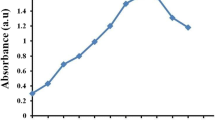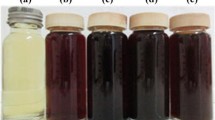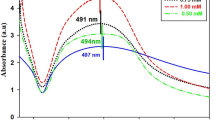Abstract
Silver nanoparticles (AgNPs) were fabricated in the presence of Falcaria vulgaris aqueous extract as a biosynthesis method without utilizing any surfactant or template. AgNPs were prepared under different synthesis conditions such as silver ion concentration and the amount of plant used for the extraction, reaction duration and temperature for the extraction. The effect of these variables on the size of resulted AgNPs was examined, and operation conditions were optimized statistically with analysis of variance (ANOVA) to describe the role of these variables in tuning the size of AgNPs. The results of ANOVA displayed the optimum conditions for the synthesis procedure that resulted in AgNPs with the average size of 28 ± 8 nm. Furthermore, the growth of AgNPs was monitored by UV-Vis spectroscopy, and they were characterized using TEM, SEM, X-ray diffraction, and FT-IR spectroscopy. Finally, in vitro antibacterial activity of the AgNPs showed the maximum inhibition zone alongside Staphylococcus aureus (ATCC 25923) and lowermost inhibition zone touching E. coli (MDR). The minimum inhibitory concentration (MIC) for the AgNP-Fv was in a range between 0.535 and 0.001 µg/ml. According to the results, the ATCC bacteria were more sensitive to AgNP-Fv compared to multiple-drug resistance bacteria, except for Pseudomonas aeruginosa (MDR).

Highlights
-
Ag nanoparticles were synthesized by a green procedure.
-
Aqueous extract of Falcaria vulgaris was used to synthesize Ag nanoparticles.
-
Taguchi statistical design was used to optimize the synthesis procedure.
-
Ag nanoparticles were characterized by UV-Vis, EDX, SEM, TEM, and FT-IR.
-
In vitro antibacterial activity of Ag-NPs was evaluated against MDR bacteria.






Similar content being viewed by others
References
Begum NA, Mondal S, Basu S, Laskar RA, Mandal D (2009) Biogenic synthesis of Au and Ag nanoparticles using aqueous solutions of Black Tea leaf extracts. Colloids Surf B: Biointerfaces 71:113–118
Rajabi HR, Naghiha R, Kheirizadeh M, Sadatfaraji H, Mirzaei A, Alvand ZM (2017) Microwave assisted extraction as an efficient approach for biosynthesis of zinc oxide nanoparticles: Synthesis, characterization, and biological properties. Mater Sci Eng: C 78:1109–1118. https://doi.org/10.1016/j.msec.2017.03.090
Sharma VK, Yngard RA, Lin Y (2009) Silver nanoparticles: green synthesis and their antimicrobial activities. Adv Colloid Interface Sci 145:83–96
Fayaz AM, Balaji K, Girilal M, Yadav R, Kalaichelvan PT, Venketesan R (2010) Biogenic synthesis of silver nanoparticles and their synergistic effect with antibiotics: a study against gram-positive and gram-negative bacteria. Nanomed: Nanotechnol, Biol Med 6:103–109
Rajabi HR, Deris H, Faraji HS (2016) A facile and green biosynthesis of silver nanostructures by aqueous extract of Suaeda acuminata after microwave assisted extraction. Nanochemistry. Research 1:177–182. https://doi.org/10.7508/ncr.2016.02.005
Borghei Y-S, Hosseini M, Dadmehr M, Hosseinkhani S, Ganjali MR, Sheikhnejad R (2016) Visual detection of cancer cells by colorimetric aptasensor based on aggregation of gold nanoparticles induced by DNA hybridization. Anal Chim Acta 904:92–97
Heydari R, Koudehi MF, Pourmortazavi SMJC (2019) Antibacterial activity of Fe3O4/Cu nanocomposite: green synthesis using Carum carvi L seeds aqueous extract. ChemistrySelect 4:531–535
Mortazavi K, Rajabi H, Ansari A, Ghaedi M, Dashtian K (2016) Preparation of silver nanoparticle loaded on activated carbon and its application for removal of malachite green from aqueous solution. Synth React Inorg M. https://doi.org/10.1080/15533174.2016.1228670
Rajabi HR, Arjmand H, Hoseini SJ, Nasrabadi H (2015) Surface modified magnetic nanoparticles as efficient and green sorbents: synthesis, characterization, and application for the removal of anionic dye. J Magn Magn Mater 394:7–13. https://doi.org/10.1016/j.jmmm.2015.06.024
Shahverdi AR, Minaeian S, Shahverdi HR, Jamalifar H, Nohi A-A (2007) Rapid synthesis of silver nanoparticles using culture supernatants of Enterobacteria: a novel biological approach. Process Biochem 42:919–923
Ahmad A, Mukherjee P, Senapati S, Mandal D, Khan MI, Kumar R, Sastry M (2003) Extracellular biosynthesis of silver nanoparticles using the fungus Fusarium oxysporum. Colloids Surf B: Biointerfaces 28:313–318
Mohapatra B, Kuriakose S, Mohapatra S (2015) Rapid green synthesis of silver nanoparticles and nanorods using Piper nigrum extract. J Alloy Compd 637:119–126
Vijayaraghavan K, Nalini SK, Prakash NU, Madhankumar D (2012) Biomimetic synthesis of silver nanoparticles by aqueous extract of Syzygium aromaticum. Mater Lett 75:33–35
Rahimi-Nasrabadi M, Pourmortazavi SM, Shandiz SAS, Ahmadi F, Batooli H (2014) Green synthesis of silver nanoparticles using Eucalyptus leucoxylon leaves extract and evaluating the antioxidant activities of extract. Nat Prod Res 28:1964–1969
Zuas O, Hamim N, Sampora Y (2014) Bio-synthesis of silver nanoparticles using water extract of Myrmecodia pendan (Sarang Semut plant). Mater Lett 123:156–159
Pourmortazavi SM, Taghdiri M, Makari V, Rahimi-Nasrabadi M (2015) Procedure optimization for green synthesis of silver nanoparticles by aqueous extract of Eucalyptus oleosa. Spectrochim Acta Part A: Mol Biomol Spectrosc 136:1249–1254
Asbaghian S, Shafaghat A, Zarea K, Kasimov F, Salimi F (2011) Comparison of volatile constituents, and antioxidant and antibacterial activities of the essential oils of Thymus caucasicus, T. kotschyanus and T. vulgaris. Nat Product Commun 6:137–140
Hamideh J, Khosro P, Javad NDM (2012) Callus induction and plant regeneration from leaf explants of Falcaria vulgaris an important medicinal plant. J Med Plants Res 6:3407–3414
Shafaghat A (2011) Volatile oil constituents and antibacterial activity of different parts of Falcaria vulgaris Bernh. growing wild in two localities from Iran. Nat Prod Res 25:368–373
Jaberian H, Piri K, Nazari J (2013) Phytochemical composition and in vitro antimicrobial and antioxidant activities of some medicinal plants. Food Chem 136:237–244
Saravanan M, Barik SK, MubarakAli D, Prakash P, Pugazhendhi A (2018) Synthesis of silver nanoparticles from Bacillus brevis (NCIM 2533) and their antibacterial activity against pathogenic bacteria. Microb Pathog 116:221–226. https://doi.org/10.1016/j.micpath.2018.01.038
Ramkumar VS, Pugazhendhi A, Gopalakrishnan K, Sivagurunathan P, Saratale GD, Dung TNB, Kannapiran E (2017) Biofabrication and characterization of silver nanoparticles using aqueous extract of seaweed Enteromorpha compressa and its biomedical properties. Biotechnol Rep 14:1–7. https://doi.org/10.1016/j.btre.2017.02.001
Shanmuganathan R, MubarakAli D, Prabakar D, Muthukumar H, Thajuddin N, Kumar SS, Pugazhendhi A (2018) An enhancement of antimicrobial efficacy of biogenic and ceftriaxone-conjugated silver nanoparticles: green approach. Environ Sci Pollut Res 25:10362–10370. https://doi.org/10.1007/s11356-017-9367-9
Khazaei M, Salehi H (2006) Protective effect of Falcaria vulgaris extract on ethanol induced gastric ulcer in rat. Iran J Pharmacol & Ther 5:43–46
Sharma R, Sharma CL, Kapoor B (2005) Antibacterial resistance: current problems and possible solutions. Indian J Med Sci 59:120
Roy RK (2010) A primer on the Taguchi method. Society of Manufacturing Engineers
Taguchi G, Taguchi G (1987) System of experimental design; engineering methods to optimize quality and minimize costs
Bayat Y, Hajimirsadeghi SS, Pourmortazavi SM (2011) Statistical optimization of reaction parameters for the synthesis of 2,4,6,8,10,12-Hexanitro-2,4,6,8,10,12-hexaazaisowurtzitane. Org Process Res & Dev 15:810–816. https://doi.org/10.1021/op200056j
Shamsipur M, Pourmortazavi SM, Hajimirsadeghi SS, Roushani M (2013) Applying Taguchi robust design to the optimization of synthesis of barium carbonate nanorods via direct precipitation. Colloids Surf A: Physicochem Eng Asp 423:35–41
Bayat Y, Pourmortazavi SM, Iravani H, Ahadi H (2012) Statistical optimization of supercritical carbon dioxide antisolvent process for preparation of HMX nanoparticles. J Supercrit Fluids 72:248–254
Pourmortazavi SM, Rahimi-Nasrabadi M, Aghazadeh M, Ganjali MR, Karimi MS, Norouzi P (2017) Synthesis, characterization and photocatalytic activity of neodymium carbonate and neodymium oxide nanoparticles. J Mol Struct 1150:411–418
Kohsari I, Shariatinia Z, Pourmortazavi SM (2016) Antibacterial electrospun chitosan–polyethylene oxide nanocomposite mats containing bioactive silver nanoparticles. Carbohydr Polym 140:287–298. https://doi.org/10.1016/j.carbpol.2015.12.075
Edition ASF (2000) NCCLS document M7-A5. NCCLS, Wayne, PA, USA
Balouiri M, Sadiki M, Ibnsouda SK (2016) Methods for in vitro evaluating antimicrobial activity: A review. J Pharm Anal 6:71–79
Hepler OE (1949) Manual of clinical laboratory methods. Manual of clinical laboratory methods (4th Edit.)
Kale RD, Jagtap P (2018) Biogenic synthesis of silver nanoparticles using citrus limon leaves and its structural investigation. In: Siddiqui NA, Tauseef SM, Kamal B (Eds.), Advances in health and environment safety. Springer, pp 11–20
Ajitha B, Reddy YAK, Jeon H-J, Ahn CW (2018) Synthesis of silver nanoparticles in an eco-friendly way using Phyllanthus amarus leaf extract: antimicrobial and catalytic activity. Adv Powder Technol 29:86–93
Rahimi-Nasrabadi M, Pourmortazavi SM, Khalilian-Shalamzari M (2015) Facile chemical synthesis and structure characterization of copper molybdate nanoparticles. J Mol Struct 1083:229–235
Rahimi-Nasrabadi M, Pourmortazavi SM, Khalilian-Shalamzari M, Hajimirsadeghi SS, Zahedi MM (2013) Optimization of synthesis procedure and structure characterization of manganese tungstate nanoplates. Cent Eur J Chem 11:1393–1401. https://doi.org/10.2478/s11532-013-0271-y
Asghar MA, Zahir E, Shahid SM, Khan MN, Asghar MA, Iqbal J, Walker G (2018) Iron, copper and silver nanoparticles: Green synthesis using green and black tea leaves extracts and evaluation of antibacterial, antifungal and aflatoxin B 1 adsorption activity. LWT 90:98–107
Rahimi-Nasrabadi M, Pourmortazavi SM, Ganjali MR, Reza Banan A, Ahmadi F (2014) Synthesis procedure optimization and characterization of europium (III) tungstate nanoparticles. J Mol Struct 1074:85–91. https://doi.org/10.1016/j.molstruc.2014.05.044
Rahimi-Nasrabadi M, Pourmortazavi SM, Davoudi-Dehaghani AA, Hajimirsadeghi SS, Zahedi MM (2013) Synthesis and characterization of copper oxalate and copper oxide nanoparticles by statistically optimized controlled precipitation and calcination of precursor. CrystEngComm 15:4077–4086
Shahidzadeh M, Shabihi P, Pourmortazavi SM (2015) Sonochemical preparation of copper (II) chromite nanocatalysts and particle size optimization via taguchi method. J Inorg Organomet Polym Mater 25:986–994
Pourmortazavi SM, Hajimirsadeghi SS, Rahimi-Nasrabadi M (2012) Applying the Taguchi robust design to optimization of the experimental conditions for synthesis of lead chromate nanorods. J Dispers Sci Technol 33:254–257
da Silva Ferreira V, ConzFerreira ME, Lima LMT, Frasés S, de Souza W, Sant’Anna C (2017) Green production of microalgae-based silver chloride nanoparticles with antimicrobial activity against pathogenic bacteria. Enzym Microb Technol 97:114–121
Vilchis-Nestor AR, Sánchez-Mendieta V, Camacho-López MA, Gómez-Espinosa RM, Camacho-López MA, Arenas-Alatorre JA (2008) Solventless synthesis and optical properties of Au and Ag nanoparticles using Camellia sinensis extract. Mater Lett 62:3103–3105
Kaviya S, Santhanalakshmi J, Viswanathan B (2012) Biosynthesis of silver nano-flakes by Crossandra infundibuliformis leaf extract. Mater Lett 67:64–66
Pourmortazavi SM, Marashianpour Z, Karimi MS, Mohammad-Zadeh M (2015) Electrochemical synthesis and characterization of zinc carbonate and zinc oxide nanoparticles. J Mol Struct 1099:232–238. https://doi.org/10.1016/j.molstruc.2015.06.044
Xu Z, Hou Y, Sun S (2007) Magnetic core/shell Fe3O4/Au and Fe3O4/Au/Ag nanoparticles with tunable plasmonic properties. J Am Chem Soc 129:8698–8699
Okafor F, Janen A, Kukhtareva T, Edwards V, Curley M (2013) Green synthesis of silver nanoparticles, their characterization, application and antibacterial activity. Int J Environ Res Public Health 10:5221–5238
Cruz D, Falé PL, Mourato A, Vaz PD, Serralheiro ML, Lino ARL (2010) Preparation and physicochemical characterization of Ag nanoparticles biosynthesized by Lippia citriodora (Lemon Verbena). Colloids Surf B: Biointerfaces 81:67–73
Elavazhagan T, Arunachalam KD (2011) Memecylon edule leaf extract mediated green synthesis of silver and gold nanoparticles. Int J Nanomed 6:1265–1278
Coates J (2000) Interpretation of infrared spectra, a practical approach. Encyclopedia of analytical chemistry
Wu X, Lu C, Zhou Z, Yuan G, Xiong R, Zhang X (2014) Green synthesis and formation mechanism of cellulose nanocrystal-supported gold nanoparticles with enhanced catalytic performance. Environ Sci: Nano 1:71–79. https://doi.org/10.1039/C3EN00066D
Lakshmi R, Ramachandran R, Syam Sundar A, Rehman F, Radhika G, Kumar V (2013) Optimization of the conventional minimum inhibitory concentration method for drug susceptibility testing of ethionamide. Int J Mycobacteriology 2:29–33. https://doi.org/10.1016/j.ijmyco.2012.11.005
Ramos JL, Duque E, Gallegos M-T, Godoy P, Ramos-González MI, Rojas A, Terán W, Segura A (2002) Mechanisms of solvent tolerance in gram-negative bacteria. Annu Rev Microbiol 56:743–768
Zgurskaya HI, Nikaido H (2000) Multidrug resistance mechanisms: drug efflux across two membranes. Mol Microbiol 37:219–225
Nies DH (2003) Efflux-mediated heavy metal resistance in prokaryotes. FEMS Microbiol Rev 27:313–339
Tiwari DK, Behari J, Sen P (2008) Time and dose-dependent antimicrobial potential of Ag nanoparticles synthesized by top-down approach. Curr Sci 95:647–655
McShan D, Ray PC, Yu H (2014) Molecular toxicity mechanism of nanosilver. J Food Drug Anal 22:116–127
Ge L, Li Q, Wang M, Ouyang J, Li X, Xing MM (2014) Nanosilver particles in medical applications: synthesis, performance, and toxicity. Int J Nanomed 9:2399
Author information
Authors and Affiliations
Corresponding authors
Ethics declarations
Conflict of interest
The authors declare that they have no conflict of interest.
Additional information
Publisher’s note: Springer Nature remains neutral with regard to jurisdictional claims in published maps and institutional affiliations.
Rights and permissions
About this article
Cite this article
Kohsari, I., Mohammad-Zadeh, M., Minaeian, S. et al. In vitro antibacterial property assessment of silver nanoparticles synthesized by Falcaria vulgaris aqueous extract against MDR bacteria. J Sol-Gel Sci Technol 90, 380–389 (2019). https://doi.org/10.1007/s10971-019-04961-0
Received:
Accepted:
Published:
Issue Date:
DOI: https://doi.org/10.1007/s10971-019-04961-0




